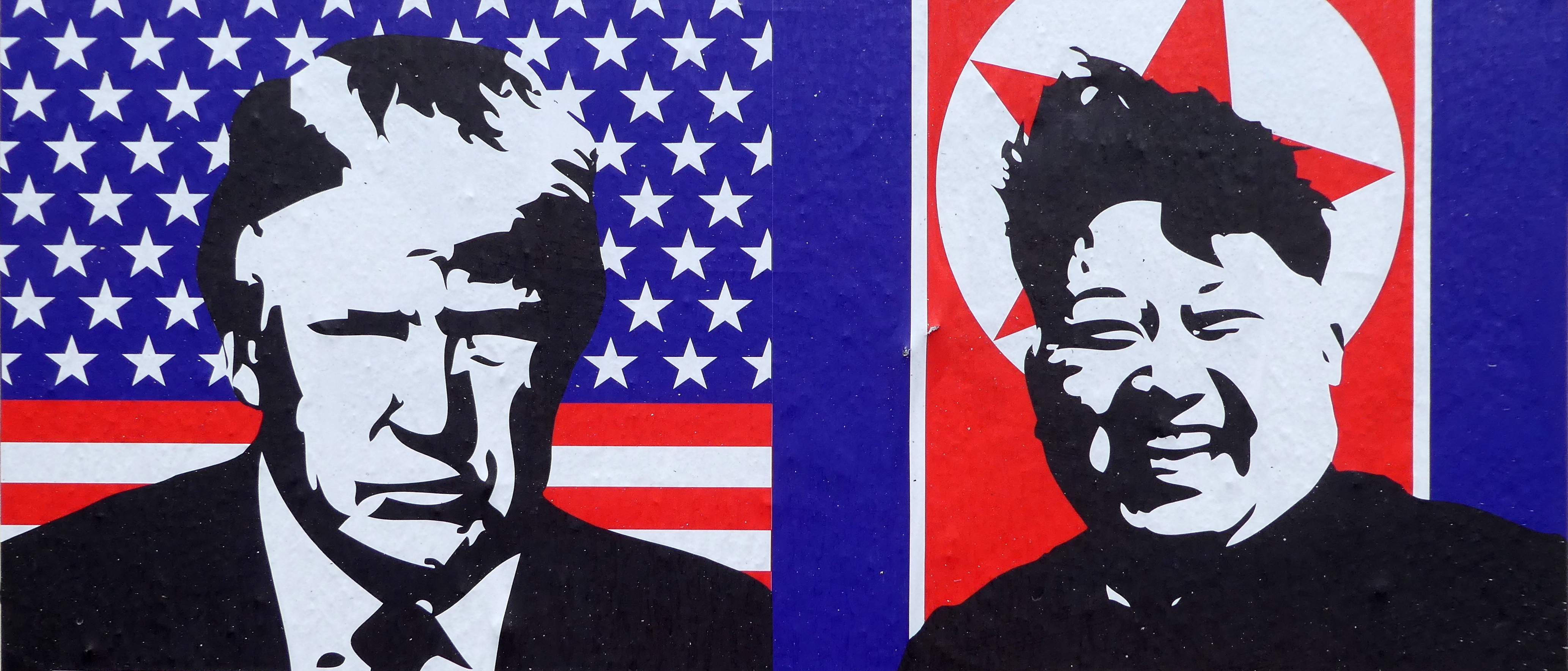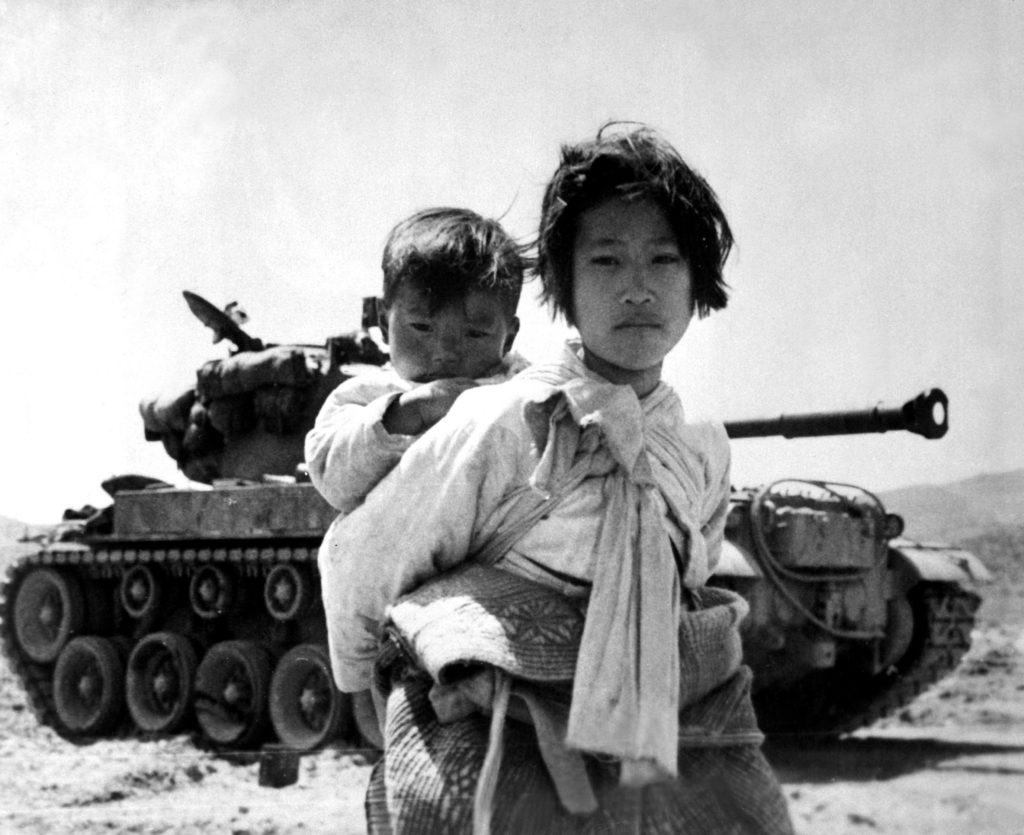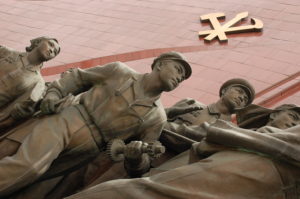The North Remembers: America’s Role in Korea’s History
 "American Psycho/Korean Psycho." Photo by duncan c. Photo has been cropped. Flickr Creative Commons. https://flic.kr/p/U8kNTe.
"American Psycho/Korean Psycho." Photo by duncan c. Photo has been cropped. Flickr Creative Commons. https://flic.kr/p/U8kNTe.
US President Donald Trump delivered a fiery speech at the UN General Assembly in September in which he threatened to “totally destroy North Korea” if the US were forced to defend itself or its allies from the Democratic People’s Republic of Korea’s (DPRK) aggression. To the casual observer of the escalating tensions between the US and the DPRK, the hawkish pronouncements coming from the President may seem to be an appropriate response to the dangerous sabre-rattling from the “Rocket Man” and his repressive regime. The prospect of nuclear war, however, is anything but casual. A true understanding of the current crisis must put today’s threats in historical context by understanding the role of American aggression in the history of Korea.
A Bloody Beginning
The roots of today’s tensions are found in the Korean War. In the US, the Korean War is commonly referred to as the “unknown” or “forgotten” war. But to North Korea, it is an atrocity still fresh in the minds of leadership and those old enough to remember it. In the aftermath of WWII, the Allied powers decided to divide Korea– ravaged by the violence of Japanese occupation– along the 38th parallel. The northern and southern halves of the newly-divided peninsula would be under the control of the USSR and the US, respectively. The division of Korea along the 38th parallel was, of course, arbitrary. Korea had enjoyed a territorial, linguistic and cultural unity for centuries, and the boundary line between the northern and southern half of the peninsula was something that few Koreans took seriously. In fact, before the North invaded the South for the purpose of reunification, South Korean president Syngman Rhee had declared his wish to unify the peninsula by force.
After the North invaded the South in an attempt to reunify the peninsula, the US stepped in to defend its ally and in the process embarked in a war that would result in the death of millions, the territorial destruction of the Korean peninsula, and the cementing of an American presence in the region until the present day.
Instead of pushing North Korea back behind the 38th parallel in its defense of South Korea, the US pushed beyond it in an attempt to “liberate” the entire peninsula. The US began a brutal bombing campaign of major population centers, and engaged in extensive use of napalm to firebomb North Korean cities. When China entered the war on the side of North Korea, the US ratcheted up the air war as it retreated to the 38th parallel while employing scorched-earth tactics to destroy the Northern landscape.
The American government also seriously considered the use of nuclear weapons in North Korea. After China entered the war, President Harry Truman warned that the US would not rule out the use of the atomic bomb in the Korean War. United Nations Command General Douglas MacArthur requested the use of 30-50 atomic bombs, which he envisioned dropping across the North Korean-Chinese border in order to establish a cordon-sanitaire and prevent any land access into Korea from the North.1 MacArthur was ultimately finally removed from his post by Truman, who wanted a more reliable commander on the scene should the US decide to use the atomic bomb. During this time, Truman approved relocating several atomic bombs to the American territory of Guam in order to be deployed for use against the advancing Chinese army. America ultimately never used the bombs as China did not significantly escalate the war, but the bombs remained stationed in Guam under military control.2
Throughout the course of the Korean War, however, the US did carry out several test runs in preparation for a potential nuclear strike. During Operation Hudson Harbour, the American military conducted a series of tests in which it dropped very heavy TNT bombs on Korean territory in order to simulate the effects of a nuclear strike, and determine its practical feasibility on the battlefield. The results of the operation ruled out use of the bomb during the war due to technical difficulties involving the identification of groupings of enemy troops.3
Despite never using the atomic bomb, the US managed to kill millions of North Koreans during the air campaign, and completely obliterate the major urban cities in which they lived. In the process, the US destroyed several irrigation dams, which provided water for 75% of Northern agricultural production, putting millions at risk of starvation, and leading to the mass flooding of Korean roads and railways.4

Living Under Threat
After the war ended in a stalemate, the US stationed nuclear weapons in South Korea in contravention of the agreed Armistice in order to deter the entire peninsula from reigniting an active civil war. As American nuclearization of Korea continued, officials were developing strategies to fend off a Northern invasion with the likely use of nuclear weapons. In response to these strategies and overall weapon deployment, North Korea began to amass ground troops near the demilitarized zone (DMZ) with the intent of mixing in with the South Korean Army and making a nuclear strike less likely.5
Even when George H. W. Bush removed nuclear weapons from South Korea, nuclear submarines remained on alert, and the military began developing new strategies for defeating and toppling the North Korean regime in the event of a military conflict. South Korea, for its part, began the development of ballistic missiles capable of reaching the DPRK with technology from American firms. In response to these actions, the DPRK continued moving troops near the DMZ and building underground facilities, warplane hangars, and munitions depots.6
In early 1993, Bill Clinton decided to resume Team Spirit military training exercises with South Korea. According to historian Bruce Cumings, these exercises involved the “introduction to Korea of nuclear-capable aircraft and naval ships of all types, back-pack nukes controlled by mobile units, practice with nuclear cannons, and so on, with many South Korean units working together with the Americans on various nuclear war scenarios.”7 At the same time, American general Lee Butler announced that the US would reorient nuclear missiles targeting the now-defunct Soviet Union in favor of targets in the DPRK. In response, the DPRK threatened to leave the non-proliferation treaty (NPT).
Though North Korea held off on withdrawal, tensions between the US and the DPRK remained high. However, a visit by former President Jimmy Carter to Kim Il-Sung laid the groundwork for a 1994 diplomatic agreement known as the Agreed Framework. As part of the framework, the DPRK agreed to halt its nuclear weapons program in exchange for oil and a light water reactor supplied by the US, and a normalization of diplomatic ties, which included an end to hostile rhetoric and military action.
The Agreed Framework did not last long. The American government delayed oil shipments and then ultimately halted them at the end of 2002. It also never built the light water reactors. Though North Korea ended its nuclear weapons program for over a decade, it began to distrust American commitment to the agreement, and eventually withdrew from the NPT in early 2003. The Framework finally met its end that same year when George W. Bush abrogated the deal. The Bush administration cited dubious and unconfirmed claims that the DPRK had been developing a uranium-enrichment program. Subsequent attempts by North Korea to reach an agreement with the Bush administration fell through when the parties involved could not agree on the issue of verifying North Korean plutonium enrichment.
Contextualizing the Current Conflict

The historical context is all the more important when understanding today’s crisis. A concerted effort is made by American officials to paint the DPRK as an irrational, rogue regime bent on the destruction of the region. Yet, understood against the backdrop of incessant American military aggression and rhetorical hostility, North Korea’s actions can in fact be seen as a rational response to the threat of annihilation by the American government.
It must be noted that a contextual understanding of the conflict does not excuse well-documented abuses committed by the DPRK, nor does it absolve the North Korean government of responsibility for the dangerous escalation to violence the atrocities it committed during the Korean War. However, if we understand North Korean threats not only as a response to the traumatic memories of a vicious civil war, but also as a defense against a fate similar to that of other American enemies, then we may develop a more complete grasp of the scope of the crisis. With this recognition, we may also learn to scrutinize the validity of American intentions in the region. In understanding the violent history of the Korean War, we may begin to challenge America’s role as a global moral arbiter and question the very legitimacy of American military power itself.
The Korean War resulted in the death of 2.5 million Koreans. A war with North Korea today would result in the death of millions more. Few are discussing the horrific implications of a military confrontation between the US and the DPRK, limiting the significance of the crisis to a schoolyard fight between two grown men. The destruction of a peninsula of roughly 75 million innocent people is something worth pondering as the standoff between Donald Trump and Kim Jong-Un unfolds. The Trump administration may conveniently forget the bloody roots of hostility, but Koreans do not; they remember. In dealing with issues like nuclear war, perhaps we could do some remembering, too.
Edited by Luca Loggia
1. Bruce Cumings, North Korea: Another Country (New York: New Press, 2004), 22.↩
2. Ibid., 24.↩
3. Ibid., 26.↩
4. Ibid., 28.↩
5. Ibid., 54.↩
6. Ibid., 55.↩
7. Ibid., 65.↩
